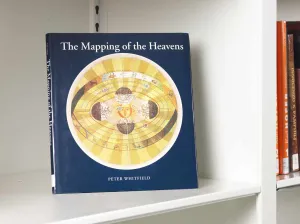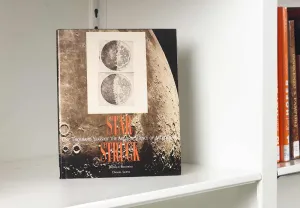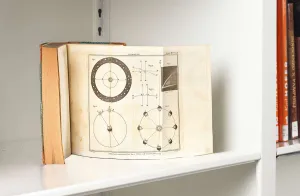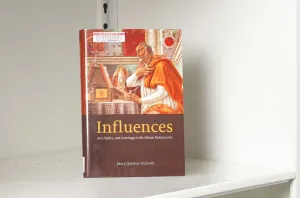Reading List: Art, Astronomy, and the Arrival of Summer
June 10, 2022
By Ralph Baylor, Interlibrary Loan and Document Delivery Lead, Frick Art Reference Library
On Tuesday, June 21, we look to the skies for this year’s summer solstice, when the Earth’s North Pole achieves its maximum tilt toward the Sun. In the Northern Hemisphere, the Sun travels its longest path through the sky on this day, resulting in the most daylight and the longest day of the year. (The Southern Hemisphere, by contrast, experiences its winter solstice, or its shortest day of the year.)
To mark the official start of summer, the Frick Art Reference Library has compiled a list of nine highlights from its holdings of books on the examination, celebration, and interpretation of celestial bodies and their movements in art and art history. The publications on this list are available for consultation with a free appointment to our reading room. The e-book (#5) can be viewed virtually thanks to our program with Open Library, which allows anyone to browse a wide selection of our digitized publications by creating a free Internet Archive account.
-
Big Bang: Imagining the Universe
By Barbara Baert (2021)
Peer through the ages of humankind’s conception of the cosmos with this catalog that merges two exhibitions that took place simultaneously in Leuven, Belgium, where priest and physicist Georges Lemaître first formulated the Big Bang theory in the 1930s, a concept that the universe began as some infinitesimal point in the past before exploding into the expanse it is today. The catalog deftly weaves historic visualizations of the universe, beginning with the Neolithic period through the nineteenth century and contemporary artworks that engage with the Big Bang theory. Essays and conversations with art historians and cosmologists offer engaging supplementary reading.
-
De compositione & usu multiformium horologiorum solarium ad omnes totius orbis regiones, ac situs in qualibet superficie
By Giovanni Padovani (1582)
Explore one of the earliest published works in the library’s collections, whose Latin title translates to “On the composition and use of various solar clocks for all regions of the globe and their locations on each surface.” The book is a fascinating example of sixteenth-century publishing during the scientific revolution in Italy, however its remarkable illustrations are what warrant its place in an art library collection. Even if your Latin does not make the grade, stunning prints of the cosmos, solar clocks, and other celestial mechanical devices are worth reflecting on five centuries later.
-
The Mapping of the Heavens
By Peter Whitfield (1995)
Plot out the heavens with this superbly illustrated book about humanity’s search to understand the universe through the creation of celestial maps. The book is global in scope, with chapters focused on Ancient Egypt, Mesopotamia, cultures of the Americas, and Islamic societies. The author also devotes a section to technologies of the twentieth century and includes maps of the universe made using non-visible light photography.
-
Star Struck: One Thousand Years of the Art and Science of Astronomy
By Ronald Brashear (2001)
Survey the history of Western astronomy in this exhibition catalog. Among the illustrations featured in this book are works from the collections of the Huntington Library in Los Angeles, along with illuminated manuscripts from the J. Paul Getty Museum and contemporary images taken during NASA space flights. The publication celebrates significant historical representations of the universe and major advancements in astronomical technologies, such as the telescope.
-
The Arctic Sky: Inuit Astronomy, Star Lore, and Legend
By John MacDonald (1998)
Tour the Arctic sky from home with a read through this e-book. The author gathers Iglulik Inuit knowledge—drawn from interviews from an oral history project with Iglulingmiut elders in Nunavut, Canada—and historical records from Arctic explorers to share a journey through the night sky as observed from Earth’s northernmost region. Readers can explore constellations, star maps, traditional stories, and atmospheric phenomena, along with songs and cosmic mythologies of the Inuit people living in the area. Transcriptions of several of the oral history interviews as well as an extensive bibliography enable further explorations through the Arctic sky.
-
Astronomical and Geographical Essays
By George Adams (1812)
Study the evolution of astronomy by comparing the Padovani book (#2) with this publication from 230 years later. The book guides readers through a thorough analysis of planetary orbits—as they were understood in the nineteenth century—and the motions of the Earth and Moon. A sales catalog accompanies the main body of the text that lists globes, celestial maps, and other astrological instruments a reader of the era could purchase to pursue their own studies of the cosmos. The text is accompanied by twelve exquisite tri-fold plates that illustrate the various phenomena Adams describes.
-
Influences: Art, Optics, and Astrology in the Italian Renaissance
By Mary Quinlan-McGrath (2013)
Zoom into the art of optics and astrology during the Italian Renaissance with this fascinating text that explains to the modern reader the intertwining of astronomy, theology, and art during that period. The author convincingly argues that the production of artworks with astrological imagery served both aesthetic and functional purposes. For example, natural philosophers (who predated modern scientists) believed that the positive mental and physical effects one gained from standing in the sunlight could be replicated through a representation of its rays in an indoor environment.
-
Painting the Heavens: Art and Science in the Age of Galileo
By Eileen Reeves (1997)
Discover how groundbreaking, and often heretical, new ideas in the field of astronomy influenced artists in the seventeenth century. European society at this time generally espoused a geocentric model of the universe, wherein Earth was the center and objects in space revolved around it. However, Galileo Galilei’s observations with the telescope in the early 1600s provided evidence in support of a heliocentric model that places the Sun in the center of the universe, first described by Nicolaus Copernicus almost seventy-five years earlier. The author examines the conflict many artists felt between depicting accurate astronomical observations and the dogmatic representations imposed by the Catholic Church.
-
The Universe Unveiled: Instruments and Images through History
By Bruce Stephenson, Marvin Bolt, and Anna Felicity Friedman (2000)
Explore the collections of the Adler Planetarium and Astronomy Museum in Chicago. This book highlights the vast range of instruments people have created to decipher the universe, from the fifteenth through the nineteenth centuries. The technologies covered include astrolabes, telescopes, armillary spheres, star charts, and celestial globes.
All photos by Joseph Coscia Jr., The Frick Collection








